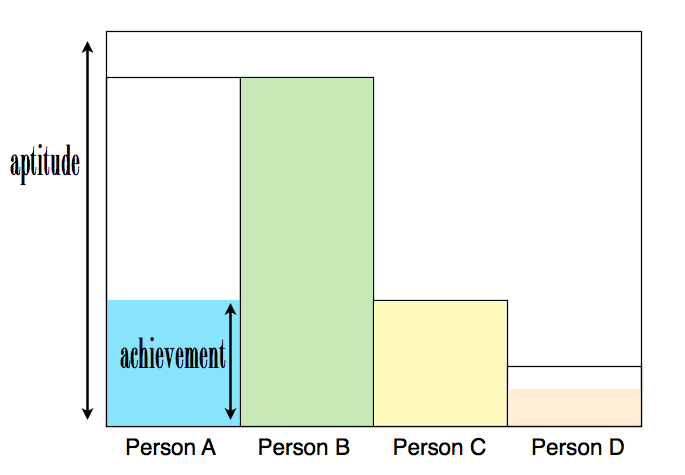Aptitude vs. achievement
/In the academic world, there is a lot of noise (i.e., research and discussion) around musical aptitude - in other words, capacity or talent. They're working on the idea that before the age of ten, whatever musical potential you have is set and you won't be able to achieve anything beyond that. Indeed, evidence suggests that most of a child's formative musical experiences occur by the age of five.
I won't speak to the validity of these assertions - I have no reason to believe that they aren't true. However, there are some dangerous and inaccurate conclusions that could be drawn.
A person might decide that because they had little early musical training, they have no hope of learning to play an instrument as an adult.
A parent might conclude that more is better and enroll an eighteen-month-old in formal music lessons, burning the child out by age four.
The fact that one's musical aptitude apparently stabilizes in childhood does not mean that one's musical achievement must take place by this time. It's also worth noting that few of us are able to achieve our complete potential in a lifetime of study in any field - there is always room to keep learning and growing.
The diagram below shows the musical aptitude and achievement of four fictional people.

Persons A and B are twins raised in the same family. As children, their parents took them to the symphony as well as jazz and bluegrass festivals. Their parents, both amateur musicians, sang and played music with the children at home, and also played recordings. The children participated in toddler music classes and enrolled in violin lessons at age four.
Both children played in orchestras in middle school and high school. Person A discontinued lessons at age fourteen, while continuing to play in the school orchestra. Person B played in elite youth orchestras and took lessons with a college professor. Person B was accepted to a well-known conservatory following high school, while Person A went to a liberal arts college to study English. Person B became the first-chair violinist of a large orchestra, earned a doctorate in violin performance, and took a position as a university professor, while Person A plays bit of bluegrass fiddle and participates occasionally in a community orchestra.
Person C's parents sang at home and played recordings. In third grade, Person C began singing in the school chorus, and took piano lessons from fourth grade until ninth grade. In college, Person C wrote songs and performed at open mics. Person C continues to play at home, and now Person C's children are taking lessons.
Person D listened to music occasionally at home and participated in general music classes at school. Neither of Person D's parents sang much at home. Person D took piano lessons briefly in third grade but did not practice - lessons were discontinued in less than a year. Today, Person D listens to the radio on the way to work and is thinking about taking guitar lessons.
As you can see, even if you believe that one's capacity for music becomes set in stone in childhood, it's not as dismal as it sounds. Both Person A and Person C have a lifetime of musical enjoyment ahead of them even though they are not at the pinnacle of musical achievement like Person B. And that window of white showing that Person D has untapped potential: that is very important! That's the difference between wishing you could play and actually playing.
These graphs are obviously reductive - the risk is that you'll walk away thinking that you have less potential than Person D when really you're in C territory. Personally, I believe that some things can't be quantified, and one of them is desire. If your heart is set on learning an instrument and you are willing to put the work in, you will succeed. My point is that musical success does not have to mean being Person B!
Musical aptitude, like athletic aptitude, becomes most relevant at the very highest levels of achievement. On any sunny Saturday morning you will see a ton of runners out and I promise you that they are not trying to qualify for the Olympic Trials. So let's not pin our Juillard hopes on our toddlers. Instead, let's show them that music is joyful, worthwhile and soul-renewing at any age. It's never too late.
